This list of big cats includes species from around the world, including Asia, Africa, the Middle East, North America, South America and Central America.
What Defines a Big Cat
Big Cat is a term typically used in reference to the four large wild cats that roar – tigers, lions, jaguars, and leopards. These big cats are members of the Pantherinae subfamily and Panthera genus.
Many times snow leopards are referred to as big cats as well because they are also members of the Panthera genus.
Some big cat lists even include clouded leopards and Sunda clouded leopards. The clouded leopard and Sunda clouded leopard are both members of the subfamily Pantherinae but belong to a different genus: Neofelis.
You will even find cheetahs and cougars on big cat lists because of their size.
Cheetahs and cougars are members of the subfamily Felinae. Cheetahs belong to the genus Acinonyx, and cougars belong to the genus Puma.
#2 African Lion
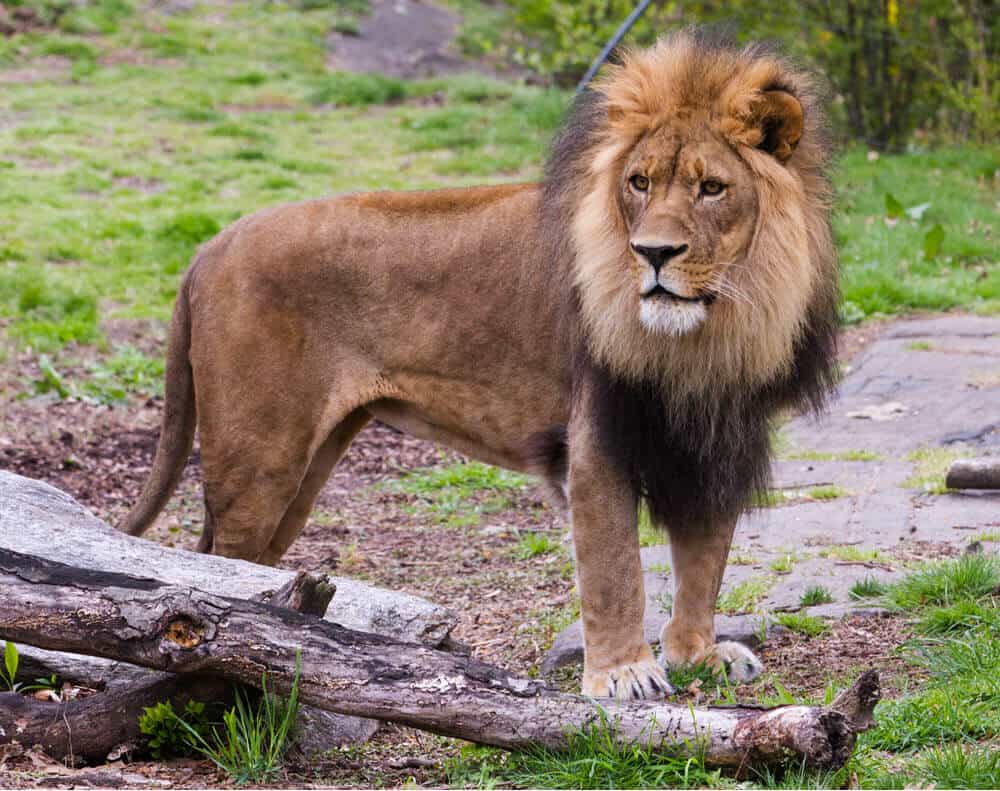
Panthera leo
Number 2 on our list of big cats is the lion. This iconic species once roamed throughout southeastern Europe, the Middle East and parts of India. While a small population still remains in India, the species mostly habitats in various parts of Africa.
- Lions live in Africa, in countries like Kenya, Tanzania, South Africa, Botswana, and Namibia, with a small population of Asiatic lions in India’s Gir Forest.
- They inhabit grasslands, savannas, and open woodlands, avoiding dense forests and deserts where hunting is more difficult.
- Lions are carnivores and primarily hunt zebras, wildebeests, buffalo, and antelopes, often working together in prides to catch large prey.
- A male lion can grow up to 10 feet (3 meters) long, including its tail, and weigh 330 to 550 pounds (150 to 250 kg), while females are slightly smaller.
- Lions live about 10 to 14 years in the wild, but they can survive over 20 years in captivity due to better care and food availability.
- A lion’s roar can be heard up to 5 miles (8 km) away, helping them communicate and warn rivals of their presence.
#3 Jaguar
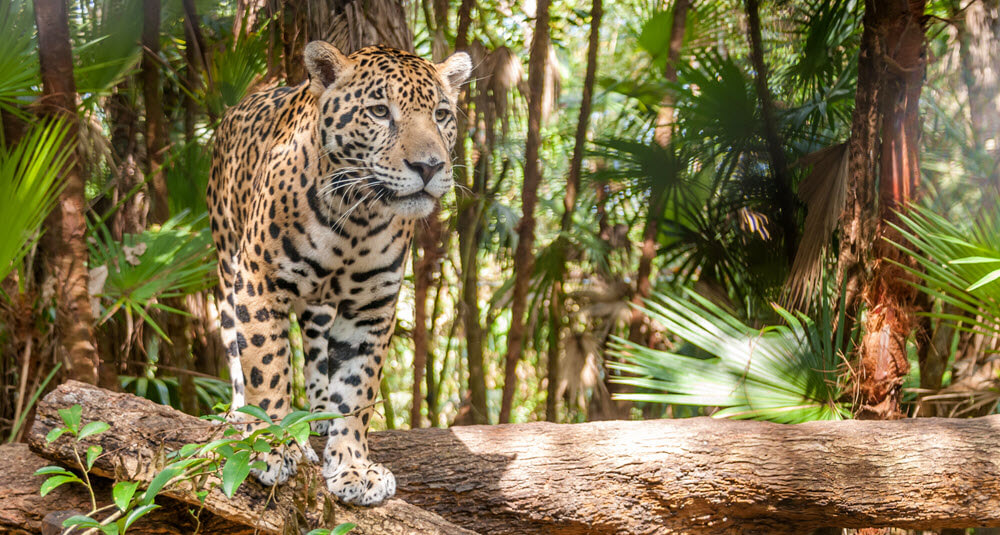
Panthera onca
Jaguars are the third largest feline on our list of big cats. They roam throughout Central and South America in forests located near rivers and lakes. Sometimes they are seen in the Southwestern United States. They are very similar in appearance to leopards, but generally larger.
- Jaguars are found in South and Central America, with the largest populations in Brazil, Venezuela, Colombia, Peru, Bolivia, and Mexico. The Amazon Rainforest is their main stronghold.
- They live in rainforests, wetlands, grasslands, and scrublands, but they are most commonly found in dense tropical forests near rivers and lakes.
- Jaguars are carnivores and eat a variety of prey, including capybaras, deer, monkeys, fish, turtles, and even caimans, using their powerful jaws to crush bones and shells.
- They are the largest cats in the Americas and the third-largest big cat in the world, after tigers and lions, weighing between 100 to 250 pounds (45 to 113 kg) and growing up to 6 feet (1.8 meters) long, not including the tail.
- Jaguars typically live 12 to 15 years in the wild and can reach 20 years in captivity when protected from threats like poaching and habitat loss.
- Unlike most big cats, jaguars love water and are excellent swimmers, often hunting in rivers and lakes.
- Their bite is the strongest of all big cats, capable of piercing turtle shells and crushing bones with ease.
- Jaguars have a unique spotted coat, which helps them blend into their forest environment, and some are black (melanistic), often called black panthers.
#4 Cougar
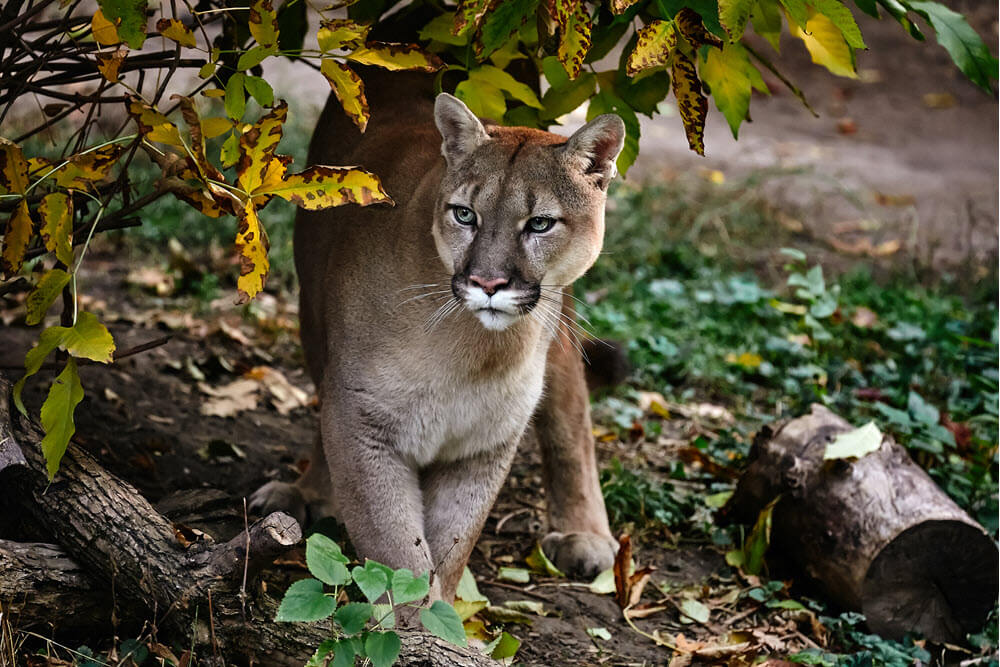
Puma concolor
Cougars are also known as the puma, mountain lion, Florida panther, red tiger, and catamount. They live in North and South America, including the United States, Canada, Mexico, Argentina, and Brazil.
- Cougars live in many different habitats, including forests, mountains, grasslands, and deserts.
- They are carnivores and eat deer, elk, rabbits, birds, and even livestock if they get the chance.
- Male cougars are around 7 feet long and vary in weight from around 120 to over 200 lbs. depending on their location.
- They have a sleek, muscular body with a long tail and short fur that is usually tan, but can range from grayish to reddish-brown.
- Cougars are excellent hunters that use stealth and powerful back legs to leap onto their prey.
- Unlike some big cats, cougars cannot roar, but they can growl, hiss, and even scream, which is why they are sometimes called “the screaming cat.”
- They are solitary animals, meaning they prefer to live alone, except when mothers raise cubs.
- Cougars are among the fastest land animals in the Americas, and they can run up to 50 mph (80 km/h) for short distances.
- Their long, powerful tails help them balance when running and jumping across rocky terrain.
#5 Leopard
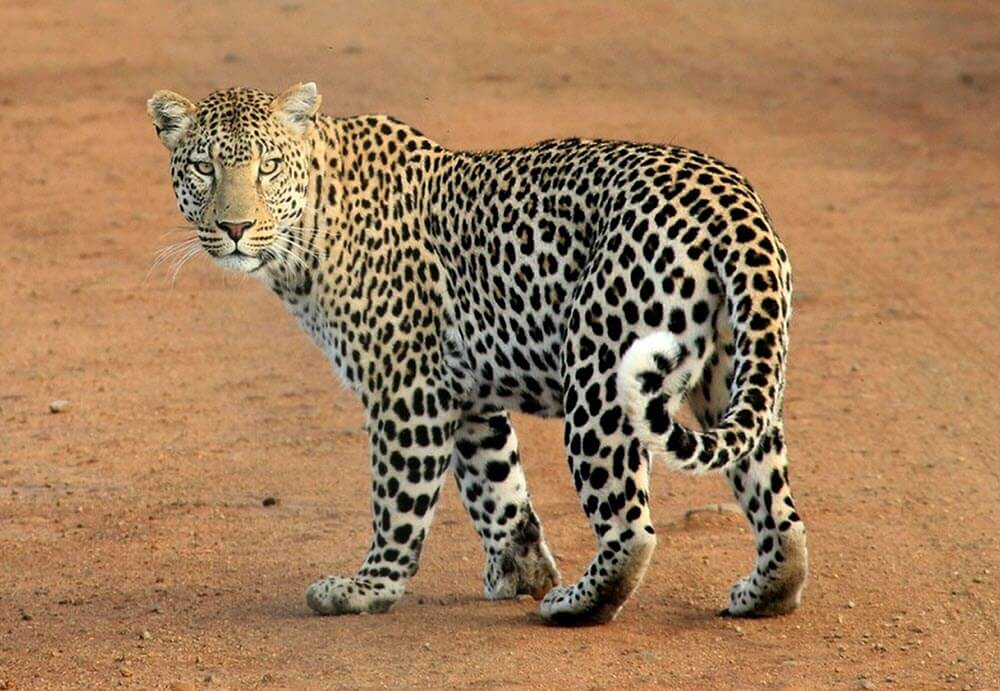
Panthera pardus
Leopards are the fourth big cat on the list. They inhabit Africa, India, Asia, the Middle East, and the Malay peninsula.
- Leopards are found in countries like India, China, Sri Lanka, Indonesia, and Russia.
- They can live in many environments, including forests, mountains, grasslands, and even deserts.
- Leopards are carnivores, meaning they eat meat. They hunt deer, antelope, monkeys, birds, and even small farm animals.
- They are strong and stealthy hunters that stalk their prey before attacking with a powerful leap.
- Unlike many big cats, leopards are excellent climbers and often drag their prey into trees to keep it safe from other predators.
- Their fur has dark rosette-shaped spots, which help them blend into their surroundings and stay hidden from enemies and prey.
- Some leopards are born with black fur instead of the usual spotted coat—these are called black panthers, but they are still leopards!
- Leopards are mostly solitary animals, meaning they prefer to live and hunt alone
- They are very adaptable and can survive in places with very little water by getting moisture from the animals they eat.
#6 Snow Leopard
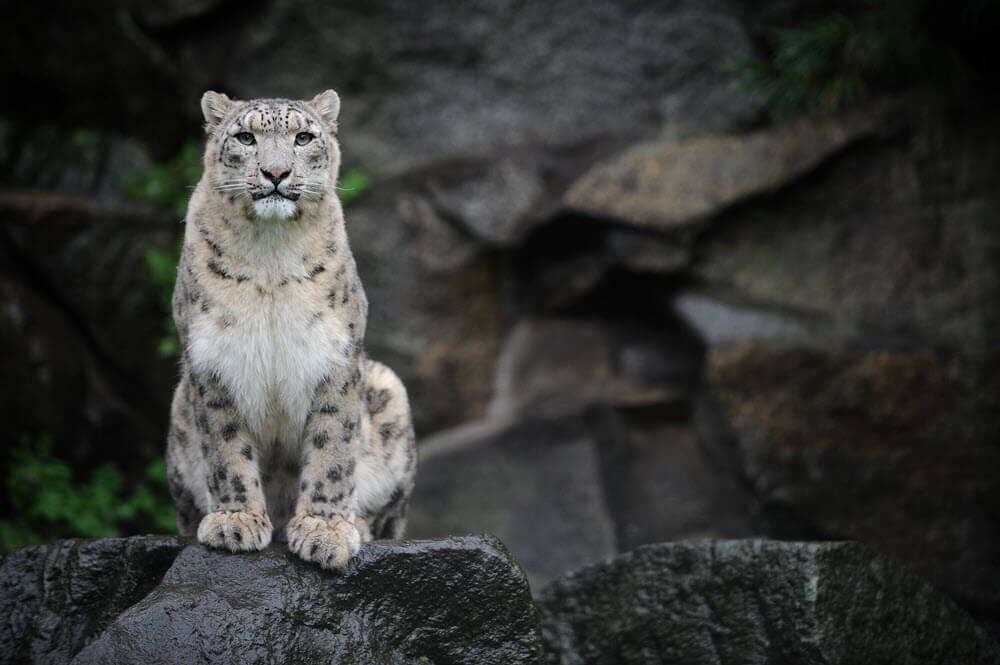
Panthera uncia
Snow leopards live in the mountains of South and Central Asia, where they have adapted to living in extremely cold climates.
- Snow leopards live in countries like China, India, Nepal, Mongolia, Pakistan, and Russia.
- They are medium-sized big cats, weighing between 60-120 pounds (27-55 kg) and growing up to 4 feet (1.2 meters) long, not including their tail.
- Their thick fur is usually grayish-white with dark gray or black rosettes and spots, helping them blend into their snowy, rocky environment.
- Snow leopards live in high-altitude habitats, often between 9,800 and 17,000 feet (3,000-5,200 meters) above sea level.
- They are carnivores that hunt wild sheep, ibex, marmots, hares, and sometimes livestock when wild prey is scarce.
- Snow leopards are known for their powerful legs, which allow them to leap up to 50 feet (15 meters) in a single jump.
- Unlike other big cats, snow leopards cannot roar; instead, they communicate with growls, yowls, and a unique chuffing sound.
- Their long, thick tails, which can be as long as their body, help them balance while climbing steep, rocky terrain.
- Snow leopards have large, fur-covered paws that act like natural snowshoes, helping them walk on deep snow without sinking.
- Snow leopards are most active at dawn and dusk, making them crepuscular hunters that rely on stealth and surprise to catch their prey.
- They have an incredible sense of hearing and sharp eyesight, allowing them to detect prey from long distances in their harsh mountain environment.
#7 Cheetah
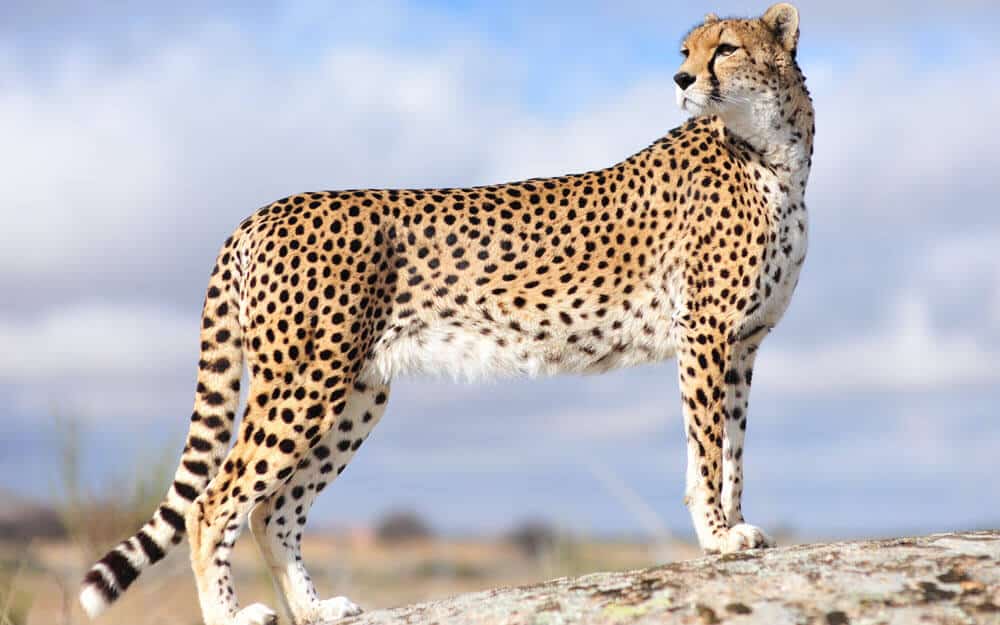
Acinonyx jubalus
Cheetahs once ranged throughout India, Pakistan, Russia, Iran and the Middle East, but due to diminishing populations, most cheetahs can only be found in the eastern and southern parts of Africa, and Iran.
- Cheetahs are mainly found in Africa, especially in countries like Kenya, Tanzania, South Africa, and Namibia, but a small population also lives in Iran.
- They have a slim, lightweight body built for speed, with long legs and a deep chest.
- Cheetahs usually weigh between 75-140 pounds (34-64 kg) and can grow up to 4 feet (1.2 meters) long, not including their tail.
- Their fur is golden-yellow with small black spots, which helps them blend into dry grasslands and avoid predators.
- Cheetahs live in open savannas, grasslands, and dry forests where they can use their speed to chase prey.
- They are carnivores and mainly hunt small to medium-sized animals like gazelles, impalas, and hares.
- Unlike most big cats, cheetahs cannot roar, but they make chirping, purring, and growling sounds to communicate.
- Cheetahs rely on their speed rather than strength, reaching up to 70 mph (113 km/h) in short bursts when chasing prey.
- Unlike leopards and lions, cheetahs do not have retractable claws, which helps them grip the ground while running.
#8 Eurasian Lynx
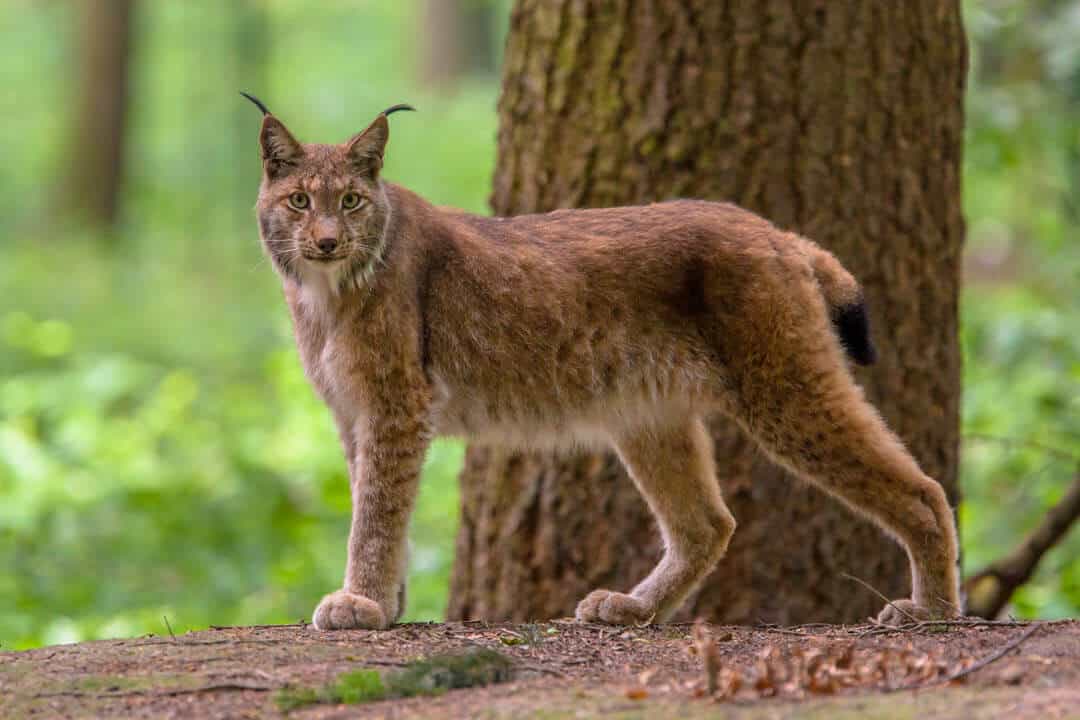
Lynx lynx
The Eurasian lynx is one of four lynx wild cat species (and the largest) found in various parts of Europe, Central Asia, Siberia, the Himalayas, and the Tibetan Plateau.
- It is found in Europe and Asia, living in countries like Russia, China, Germany, Finland, Sweden, and Mongolia.
- Eurasian lynxes are medium-sized wild cats, weighing between 40-80 pounds (18-36 kg) and growing up to 4 feet (1.2 meters) long.
- They have thick fur that changes color with the seasons—reddish-brown in summer and grayish in winter—to help them blend into their surroundings.
- Their fur is covered in dark spots, and they have long black tufts on their ears, which help them detect sounds.
- Eurasian lynxes live in dense forests, mountains, and cold, snowy regions, where they are well-adapted to survive harsh winters.
- They are carnivores that hunt deer, rabbits, hares, birds, and other small mammals.
- Unlike some wild cats, Eurasian lynxes are excellent climbers and swimmers, helping them hunt in a variety of environments.
- They are solitary animals, meaning they prefer to live and hunt alone, except during the mating season or when a mother is raising her kittens.
- Eurasian lynxes have large, fur-covered paws that work like snowshoes, helping them walk on deep snow without sinking.
#9 Clouded Leopard
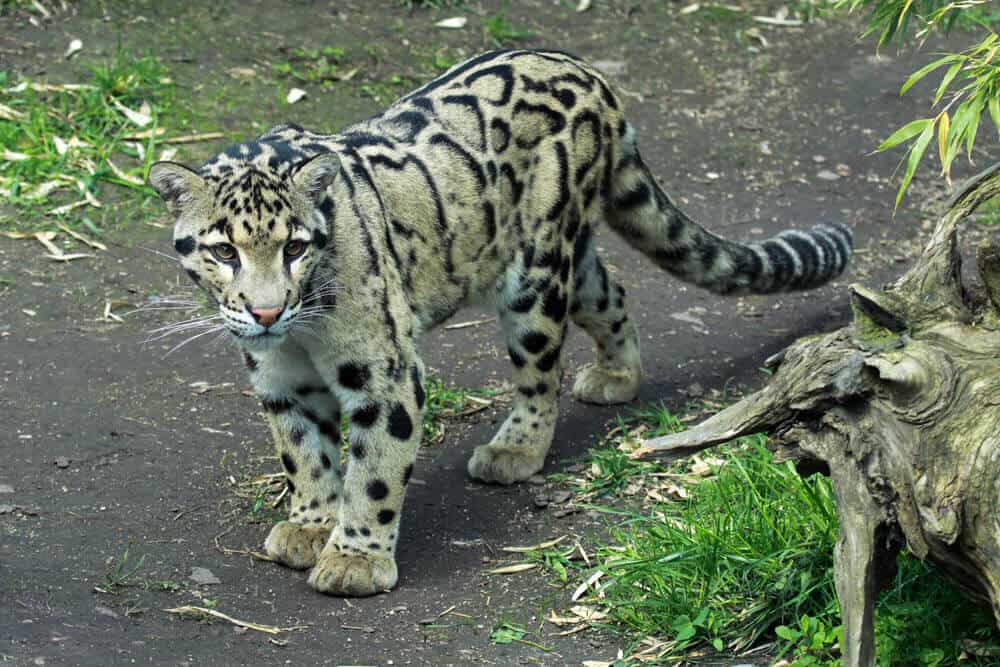
Neofelis nebulosa
The clouded leopard is found in Asia, from the Himalayas (Nepal and India) to China, usually in dense forrest. Physical characteristics include a dark grey fur with black spots, blotches and mottled stripes. It is estimated that there are less than 10,000 clouded leopards in the wild.
- Clouded leopards are found in countries like India, Nepal, Thailand, Malaysia, Indonesia, and China.
- They are smaller than other big cats, weighing between 25-50 pounds (11-23 kg) and growing up to 3.5 feet (1.1 meters) long, not including their tail.
- Their fur is yellowish or grayish with large, cloud-shaped black markings, which help them blend into the dense forest.
- Clouded leopards live in tropical rainforests, mangrove swamps, and mountainous forests, where they are well-hidden among the trees.
- They are carnivores that hunt monkeys, deer, birds, rodents, and other small animals.
- Clouded leopards are amazing climbers, using their large paws and long tails to balance as they leap between trees.
- They have the longest canine teeth of any wild cat relative to their skull size, giving them a powerful bite.
- Unlike most big cats, clouded leopards can climb down trees headfirst by rotating their ankles, a rare ability among felines.
- They are secretive and mostly nocturnal, meaning they are active at night and very difficult to spot in the wild.
#10 Sunda Clouded Leopard
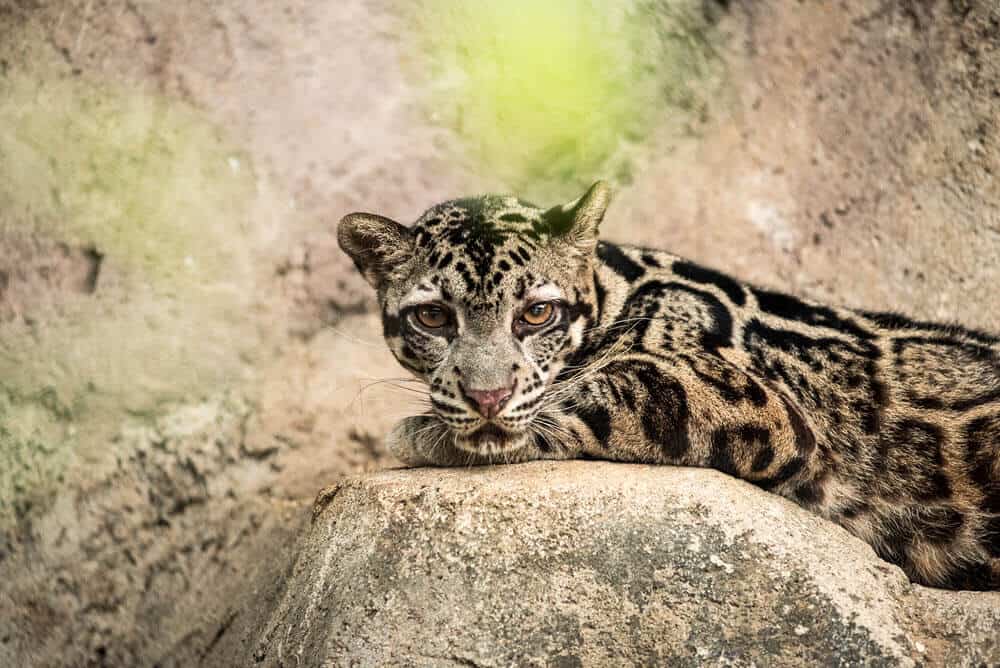
Neofelis diardi
The Sunda clouded leopard (Neofelis diardi), also called the Sundaland clouded leopard, is found in Sumatra and Borneo. The leopard’s local name means “tree branch tiger.”
- It lives in Indonesia, specifically on the islands of Borneo and Sumatra.
- Sunda clouded leopards are slightly smaller than their mainland relatives, weighing between 22-50 pounds (10-23 kg) and growing up to 3.5 feet (1.1 meters) long, not including their tail.
- Their fur is grayish or yellowish-brown with large, cloud-like black markings that help them blend into their rainforest habitat.
- They live in dense tropical rainforests and mangrove swamps, where they are well-hidden among the trees.
- Sunda clouded leopards are carnivores, hunting monkeys, birds, deer, small mammals, and even porcupines.
- They are expert climbers, using their strong legs and long tails to balance while moving through trees.
- Like the mainland clouded leopard, they have long canine teeth, giving them a powerful bite for their size.
- Unlike most cats, they can climb down trees headfirst by rotating their ankles, making them one of the most agile tree-dwelling predators.
- Sunda clouded leopards are rare and elusive, mostly active at night, and difficult for researchers to study in the wild.
Comparison of Big Cats
| Ranking | Wild Cat | Average Length (ft) | Average Weight (lbs) | Subfamily | Genus |
|---|---|---|---|---|---|
| 1 | Tiger | 7.9 – 10.8 | 308.6 – 674.6 | Pantherinae | Panthera |
| 2 | African Lion | 8.2 – 10.8 | 330.7 – 496.0 | Pantherinae | Panthera |
| 3 | Jaguar | 5.2 – 6.1 | 123.5 – 348.3 | Pantherinae | Panthera |
| 4 | Cougar | 4.9 – 9.0 | 116.8 – 220.5 | Felinae | Puma |
| 5 | Leopard | 4.6 – 6.6 | 66.1 – 198.4 | Pantherinae | Panthera |
| 6 | Snow Leopard | 3.3 – 4.9 | 48.5 – 121.3 | Pantherinae | Panthera |
| 7 | Cheetah | 3.6 – 4.9 | 46.3 – 158.7 | Felinae | Acinonyx |
| 8 | Eurasian Lynx | 2.6 – 4.3 | 39.7 – 79.4 | Felinae | Lynx |
| 9 | Clouded Leopard | 2.5 – 3.5 | 24.3 – 50.7 | Pantherinae | Neofelis |
| 10 | Sunda Clouded Leopard | 2.1 – 3.1 | 22.0 – 57.3 | Pantherinae | Neofelis |
Frequently Asked Big Cat Questions
What are the biggest cats that roar?
There are only four cats that roar, and all of them are big cats: the tiger, lion, jaguar, and leopard. These four belong to the genus Panthera and have a unique set of bones, cartilage, and ligaments in their throats that allow them to produce deep, resonant roars.
What are the fastest big cats?
Of the 10 biggest cats, the fastest are the cheetah, cougar, jaguar, lion and leopard.
Cheetah – 75 mph (120 km/h)
The cheetah is the fastest land animal, capable of reaching this speed in short bursts over distances up to 1,500 feet (460 meters). It can accelerate from 0 to 60 mph in just a few seconds.
Cougar – 50 mph (80 km/h)
Cougars are powerful sprinters and can reach high speeds for short bursts, typically while ambushing prey.
Jaguar – 50 mph (80 km/h)
Jaguars are strong and agile but rely more on stealth and ambush rather than long chases.
Lion – 50 mph (80 km/h)
Lions are fast sprinters but can only maintain their top speed for short distances due to their muscular build.
Leopard – 36 mph (58 km/h)
Leopards are agile and fast runners, but their hunting strategy relies more on ambush than prolonged chases.
The other big cats—tiger, snow leopard, Eurasian lynx, clouded leopard, and Sunda clouded leopard—are generally slower, ranging from 30-40 mph (48-64 km/h).
Which of these big cats has the longest tail?
The big cats with the longest tail relative to their body size are the snow leopard, clouded leopard, Sunda clouded leopard, leopard and jaguar. Tigers and lions have long tails but not relative to their body size.
Where do the biggest cats live?
The biggest cats live in Africa, Asia, Central America, Middle East, North America and South America.
Lions, leopards, and cheetahs live in different habitats across Africa, each suited to their way of hunting and surviving.
Big cats in Asia include Asiatic cheetahs, Amur leopards (a nearly extinct leopard subspecies), Sunda clouded leopards, clouded leopards, Asiatic lions, snow leopards and tigers.
Jaguars and cougars (pumas) roam throughout Central America. The Jaguar is the largest of all the big cats in the Americas. Although a few live in the US, they typically range from Mexico to Central and South America. Cougars can be found in both the Eastern and Western half of the region.
In South America, you will find Jaguars and cougars (pumas) in many different regions.
Big cats in the Middle East include the Persian leopard, Asiatic cheetah and Arabian leopard.
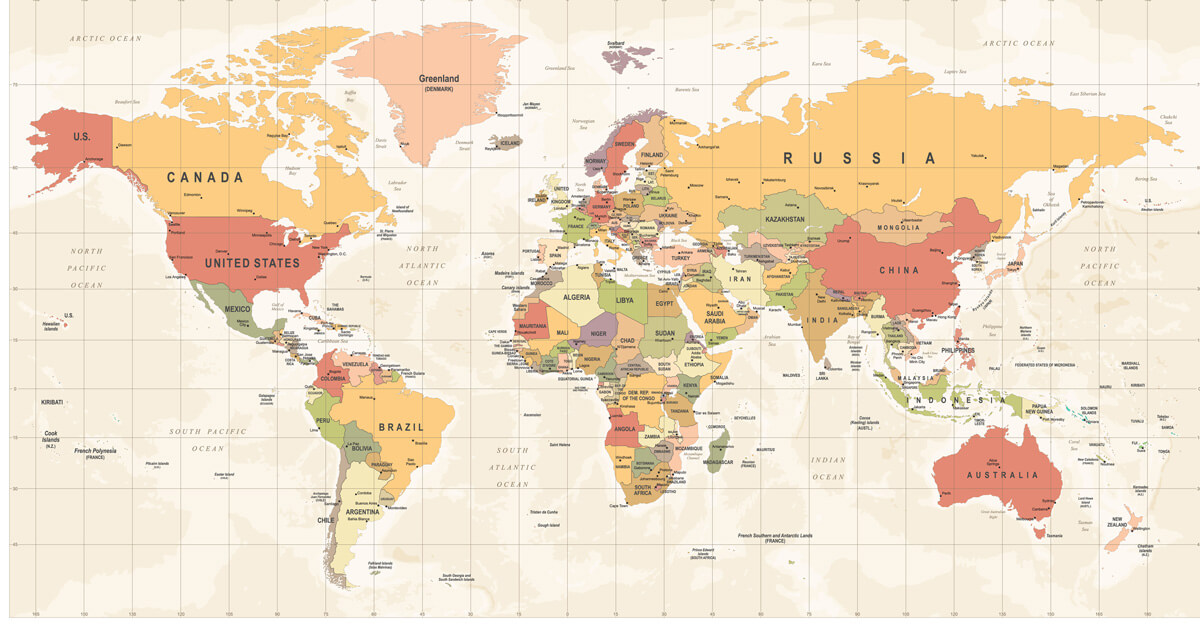
Which of the biggest cats are the most endangered?
Big cat populations are declining worldwide due to illegal wildlife trade, hunting, poaching, habitat loss, prey depletion, and human conflict. Many big cats are listed of the on the Red List of Threatened Species. When a species is endangered, it is at risk of extinction (disappearing forever).
Among the 10 largest big cats, the most endangered species based on their conservation status are:
- Sunda Clouded Leopard – Status: Vulnerable (Population Declining)
The Sunda clouded leopard is found only on the islands of Borneo and Sumatra. Deforestation, habitat fragmentation, and poaching have severely impacted its population.
- Snow Leopard – Status: Vulnerable (Population Declining)
Snow leopards are threatened by habitat loss, poaching for their fur and bones, and conflict with livestock farmers.
- Clouded Leopard – Status: Vulnerable (Population Declining)
The clouded leopard is threatened by deforestation and illegal wildlife trade. As forests are cleared for agriculture and palm oil plantations, their habitat continues to shrink.
- Tiger – Status: Endangered (Population Increasing but still at risk)
Tigers are one of the most endangered big cats, with fewer than 5,000 individuals in the wild. Habitat destruction, poaching, and human-wildlife conflict remain major threats, although conservation efforts have helped stabilize some populations.
- Lion – Status: Vulnerable (Population Declining)
Lions face habitat loss, conflicts with humans, and a decline in prey species. Their populations have dropped significantly outside of protected areas, especially in West and Central Africa.
Other Species and Their Conservation Status:
Jaguar – Near Threatened (Stable in some regions but declining in others due to deforestation and poaching).
Leopard – Vulnerable (Highly adaptable, but some subspecies are critically endangered).
Cheetah – Vulnerable (Declining due to habitat fragmentation and human-wildlife conflict).
Cougar – Least Concern (Some populations are declining, but overall species is stable).
Eurasian Lynx – Least Concern (Some regional populations face habitat loss, but overall species is stable).
Promote big cat conservation. Share this article on social media.

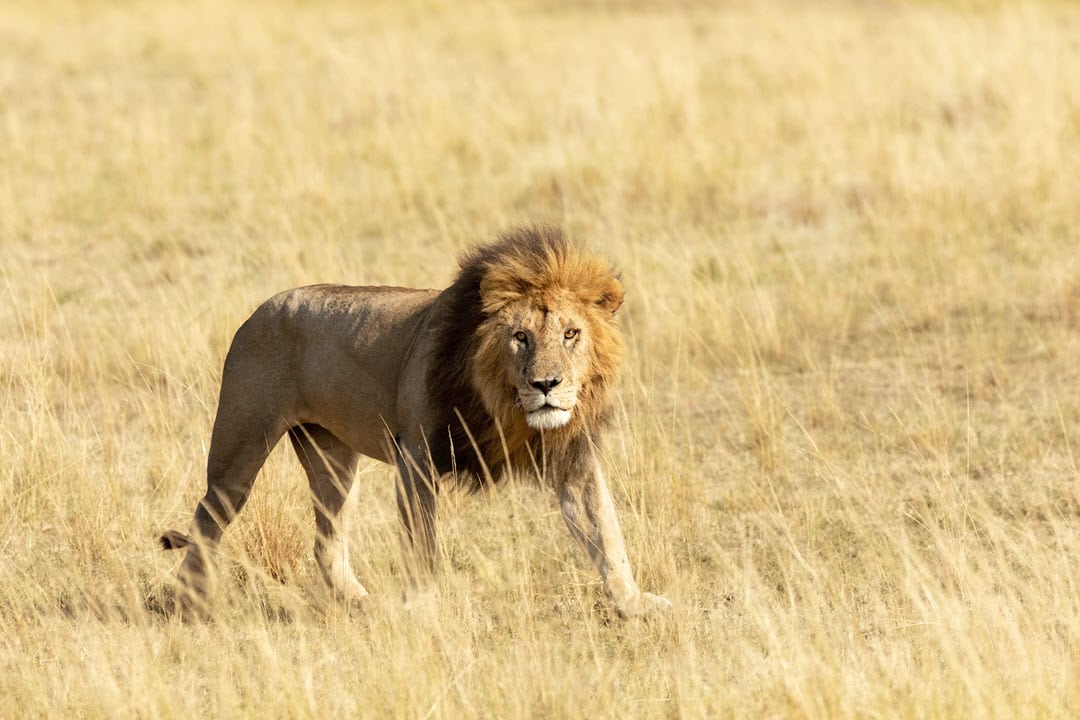
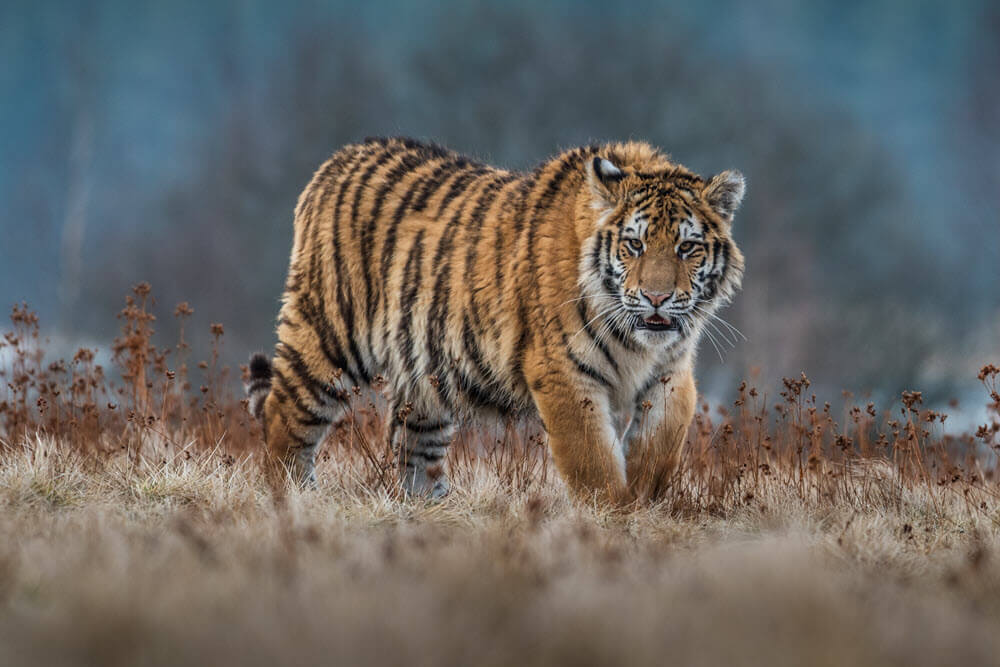
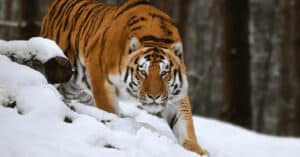
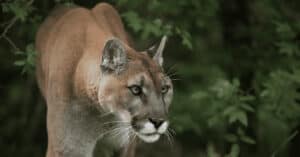
Hi! These animals are so cute!
Dogs are better
I LOVE this website! ?!!! Except, I think you should add a few more big cats/Wildcats; Black Panther, Sand Cat, Jaguarundi, Fishing Cat, Margay, Lynx/Bobcat. I am obsessed with big cats and love them! Thank you for making this!
I LOVE BIG CATS AND THOSE WHAT I JUST SAW THEY WERE SO CUTE!
Great work
My family is trying to name all if the big cats in the world i would of thought there was more we didnt know about if you know anymore then whats on this website please commet on my comment and tell me.
thx good info
I have been all over the internet and cannot find an example of the footprint of a Jaguar. Ideally, I could see it next to that of a Mountain Lion, Any help appreciated.
help the big cat family and the rest of the cat family!!!!!!!!!!!!!
what are the big cats with stripes on their heads and spots on their backs?
dont worry some1 will eventually build a time machine and we can see all the truth! dont worry dont give up !
very helpful article
I love cats because they are so cute!
Cats whether big or small, they are very adorable. I missed my cat in the Philippines 🙁
thanks for giving these big cats another chance to live.
Why are panthers not listed here?
Why do people want to kill this cute little cat family(or any animal) animals? They are so mean, rude and nature haters. 🙁
Hey! I agree there are ,any species that should not have been extinct like the baji tiger
Hi,
Big Cats generally refer to the 4 largest members of the Panthera genus. These are cats that roar – the tiger, lion, jaguar and leopard. There is also an expanded definition that includes snow leopards, puma, clouded leopard, Sunda clouded leopard and cheetah. We use the expended definition on this site.
Best,
DC
Cats are my favourite animals and I’m researching to make a quiz! 🙂 Sadly, animals are disappearing. I am big on the environment.
Do Lynx classify as big cats? Or even Bobcats? Just wondering.
Nobody ever remembers the rare white lion
I couldn’t help noticing. Aren’t Pumas (cougars) and Cheetahs considered part of the ‘small cat’ or ‘lesser cat’ species? Not to say they’re little by any stretch, but I thought they weren’t among the Great Cats (Big Cats) because of a few crucial differences, such as not being able to truly roar (no floating hyoid bone) and, at least in the cheetah’s case, being able to purr.
What about the (Puma)?
isn’t there an ocelot??
Before come this site…
I was very confused with different big cats…
I knew only about lion and tiger…
You gave me the chance to know about all difference between lion tiger etc…
Thks for telling us…
?☺???
hi. I just want to say I like and love to watch animal channel everyday. whenever am alone
Sir, i love this website it is good but i want to know about black leopards, and jaguars there is any special name for them kindly replay me……..
I love all kinds of animals I am very interested in being a animal doctor for all kinds of animals that is why I am trying very hard to raise more awareness all different wild cats are very interesting I am in 8th grade so I still have a lot longer to learn about all different kinds of animals they are very in Important and should be protected .
A.G
Thus is a good and informational list but aren’t panthers big cats too?
Is this a correct assumption? Dark and black big cats are close to equator and lighter to white away from equator ….
Very beautiful
thank you for listing pictures of all the big cats and where they live. I would really love to have seen pictures of the smaller cats also. Can you please include them in and on this site
THESE ARE NOT ALL BIG CATS
i like all types of wild cats but my favorite is the loin
Can a clouded leopard mate with a snow leopard? Thanks. robertkanyike@yahoo.com
my favorite big cat is the lion and I would like to get one
Thankful for this big cat website answering big cat questions worldwide.
Hypothetical question: if I am hiking and feel like a courgar/puma is stalking me, should I “one up it,” gaining the upper hand and living to hike another day? Or should I let nature take its course?
Jaguars are superior. In a death cage match, which large cat wins?
The fact that this website exists brights my everyday. You would probably actually be surprised how many times this website has been the answer for my big cat questions. Thank you. Thank you.
I’m personally a dog person.
I love big and small cats! and this list was very fascinating. But I was wondering if a list of Machairodontinae (sabertooth cats), Because I have been fascinated with the smilodon specie for a while now, and I always thought they were cats, however recently I watched a documentary, and they stated that sabortooths cats are not cats at all, instead they are possums? But I am confused because I have studied sabretooth cats on the internet for a while now, and the internet says they are a part of the cat family. What are they?
I would just like to see a resource that shows what a sabretooth cat is, and what is a sabretooth possum?
I love big cats and little cats! and this list was helpful. But I was wondering if you can make a list of machairodontinae (sabortooths cats), because I was wondering if they are cats are not, on the internet it says they are, but recently I watched a show and they said they are some kind of possum, which confused me, but wish to know which are cats and which ones are possums.
Dijo Thomas have Found a NEW Species – NeelagiriKaduva, which is Critically Endangered & highly Rarer than even Pandas; Bigger than a Leopard; on 25 September 2014, in Kerala, India !!!
http://www.wildlifeconservations.com/PattiKaduva.htm
At Present there are only 7 Big Cats [Lion, Tiger, Leopeard etc.]. The New Species is the 8 th Big Cat in the world !
NeelagiriKaduva is the Rarest animal in the whole world, with a confirmed population [by Dijo Thomas] of initial 4 {now only 2 adults remaining (as 2 cubs were killed by local people on two different occasions)}, highest probability of 10 and maximum possibility of only 25-30 [highly unlikely] in the whole world!
dijothomas1@gmail.com
this really helped me with my world history homework 🙂 thank you very much! i think i will get an A on it!!!!!!!!!!!!! thank you once again 🙂
I love all animals and my fave one is the cheetah plz help to save all the animals out there that r becoming in danger. What if u were one of those animals. Just plz help save them and watch them increase their breed, if u do, u do not no what will happen but it will be good.
Thank u to everyone who cares and people who don’t think again.
I LOVE BIG CATS THIER NOT GOING TO DYE
this girl on youtube said cheetahs aren’t big cats and i was like what even though your a zookeeper you do not know alot.
Well,although i am young,an 11yrs old nigerian, i love
animals.labradors and all types of cats are adorable babies.i love your site and wish to run an organisation like that.toodloo!
Well,although i am young,an 11yrs old nigerian, i love
animals.labradors and all types of cats are adorable babies.i love your site and wish to run an organisation like that.
From the list of big cats, Tiger, Leopard, Clouded Leopard among big cats and Golden Cat, Marble Cat, Fishing cat etc and more are found in Bangladesh. The situation for them here is so critical and horrific. The invasion of so called “development” is about to wipe them out. Last Tiger Census of Bangladesh says that there is only 106 Tigers in the Bangladesh part of Sundarban, the largest Mangrove forest in the world.
I have a question. Why does the government of those country were big cats are found allow trophy hunters to hunt big animals particularly the big cats?
Why cant they let those hypocrites fellas go and hunt crocs which i dont like or go and hunt for posionous snakes?
Or otherwise leave the animals roam freely in there natural habitat and you live in your own. So that they wont attack you. I dont see it a good reason for this Hunting game. This people are sick in brain
Countries with big cats should be proud of those animals as it is only found in your country, while others dont have them. Some are being to the edge of extinction now. I believe each individual person or group must now act to proctect such beautiful animals in your country
Hi, I’m Harold. I’m from Papua New Guinea just north of Australia. I am an animal Lover, especially the Cats and Dogs. Unfortunately I dont have big cats in my country however we have small cats only and dogs of many kind. But i feel sad when i see this big cats being hunted for and killed or animals killed. If only you love animals you will know how to treat other people well. Coz you will learnt many from the animals
I love all cats.I wish i was in a country where there is big cats where i can look after each species in an area
I want to see ocelots and bobcats for pics can you add some other than that it’s a good resource thanks
Protecting and conserving nature is my innate hobby. Currently, a geography teacher in Kenya, I cannot resist in mobilising students to protect flora and fauna for posterity through fieldwork. All agencies working to safeguard the cat family on this planet deserve a pat on the back.
I love big Cats
Me To
good very……………..
I love big wild cats i wish people would take more care of them.Where they live everything depends on each other. habitats need them we need to help them survive not die.we need them we need to help them NOW
IM only twelve and I think that we should stop killing these creatures its like killing people were mammals too I wish I could see these people spend life in prison for what these people do the big cats were here before us them and other animals shaped what we people are destroying
Hi my name is Isha and this is a wonderful site!! However these big cats are endangered and if they become extinct I couldn’t even imagine a world and thus it would be hard for children in the next generation to learn about them. They don’t kill us, so why should we kill them??? It doesn’t sound right. What did they ever do to u that u have to KILL them???
i love big cats like tigers.
can you save them and do try
I love cats, all cats. the only problem on earth is humans, specially trigger happy hunters, i think they should all be disarmed and send into the cats area and lets see who hunts who then.
Cats an animals deserve and need their skin more then humans.
I would die if cat species go extinct.
I love cats evermore……in that cat family I love cheetah more than ever ……its posture …..desine…..fa speeed ossssummmm ……no word s it to a
bt u cheeetha …..love u…..cheeth
Hi , have a love for all animals have had dogs , birds , fish, mice , that’s the short list, am 62 now can’t keep up with dogs, so have 4 cat’s. I’ve been reading your messages and as far as policing large areas would it be a whacked out idea if you would ask for help from a satellite company to give you access for a few hours a day or week to watch for illegal movement in the larger jungles . Like you see on NCIS or other shows or am I just whacked out. Hope you have all success in bringing change to the idiots, spending billions to kill each other a small portion of that would make a difference to save any life would be good P.R. no.
I love this website so much! I love learning about these incredible creatures! I hope to work with them someday!
Hi, I’m Ruth-Daniela and I’m an animal lover.
I cannot imagine and wouldn’t wanna imagine our beautiful planet without animals, cats especially. As vicious as they can be, they add beauty to this whole planet.
It’d be rude and harsh to destroy forests because that would mean destroying the home of cats and other animals.
Hi Mahendra,
We couldn’t agree more! Thank you for commenting…
Best,
D.R.
Hi, i am Mahendra i have a unique place in my heart for those animals. Saving those animals are important. Else we have to show the pics and videos of animals to the next generation children and more over the beauty of the natural and forest resoure will be vanished,that should not happen. Those cats should be saved.
Hi Lynsey, thank you so much for writing. Yes, it would be very sad for many reasons if these beautiful and amazing wild cats became extinct, including the disruption and collapse of ecosystems (communities of living organisms) that we depend on for our own survival.
D.R.
this is so sad! we need to save these poor animals–can you imagine life without them!!!!!!!!!!!!!!!!!!!!!!!!!!!!!!!!!!!!!!!!!!!!!!!!!!!!!!!!!!!!!!
Hi Harold, your help will always be needed and wanted. Thank you for caring…
Best,
DR
This page https://bigcatswildcats.com/panther/ has information on panthers. It’s a general term.
Best,
DR
The very fact that lions and most big cats are going to be wiped out really scares me I love lions and I hope that there still around long enough so that my kids can see them
I am so glad that someone is doing something like this, raising awareness about big cats. I feel frustrated that, as a 12 year old trying to stand up for these majestic creatures, only my girl scout friends and parents and a few friends outside of my troop listen to me without being bored to death or thinking it’s cute that I’m trying to make a difference at such an age. I hope to one day post something somewhere, proposing a petition saying straight-up that African governments with this problem in their country need to stop sitting around and letting this happen. If lions go extinct, for example, as one of the most popular big cats, the tourism in African countries will drop to nearly zero, I’m sure. I’ve seen lions with my own bare eyes before during a safari, and let me tell you, anyone with a heart would melt at the sight of that lioness jumping across the river, and her cub gets wet trying to follow her! Maybe I’ll encourage my girl scout troop to do something to raise awareness, but my goal is to post that petition. Unfortunately, at an age so young, I have no voice to adults, let alone governments…
I think it time we have to look for a good solution to save the remaining species am doing wild life management at sokoine university in Tanzanian it is so painful if you see how threaten this animal are measures should be taken if we real want to save the remaining species and education to local people will help to reduce unless we will conserve nothng
I just wanted to say thank you for help saving the big cats and to show my appreciation for my class business I am doing a report and making t-shirts and putting facts and pics about the big cats to help them get off the list of extinction I just luv the big cats and I can’t imagine this whole world without them in my life band I’m thinking of starting my own real business of saving the big cats. I know this isn’t much but it’s all I can do for right now.
Thank you.
Ok so I have a small question, is it really true that lions attack cheetahs for no reason? Because I have heard many rumors that it is true…
*I Love Cheetahs! Such a beautiful animal & so majestic*
big cats are a part of nature and i refuse to let them go extinct. They deserve more help to bring their populations back up. People need to stop taking their habitat so they can live on. By the way Bronwyn Noble, they’re not helping kill the big cats by posting comments, they are just posting how they feel and that they should be protected. Bronwyn Noble, if your going to put people down like that, its going to prevent people actually doing things about it, which comes back to you you killing what you love.
Big cats deserve more respect and we need to do something to prevent people killing them.
awesom
Thank you, this list was just what I was looking for. My daughter, who is 7 fell in love with big cats a few years ago and I have been collecting realistic plushies of all the big cat types for her. Does anyone know of any conservation websites that sell these types of toys for children? Ive managed to find many different types, but Im having trouble with the lesser known wild cats like the caracal, serval, jaguarundi, etc and any help would be appreciated. I really want to encourage her love of these animals and her desire to learn about them.
HI i really like big cats i do everything to help them i donated money and items to help them i just wish people would save and protect them instead of hurting or killing them it makes me sick why cant they stop i really appreciate what people are doing to help them thank you from hmh
what is Panther…..?
Hi, I’m so sorry to hear that nearly every big cat is endangered. If I could, all the hunters would be the hunted. I want to do more than raise awareness, I want them to survive, to thrive! Why can’t a world work together to save these majectic species? We’re killing them, yet we don’t know them. Hope this changes!
I, too, love cats of all sizes. However, loving them will not stop people with money to burn from commisioning people who have no other way of making money to go out and kill a leopard for its skin or an elephant for its ivory.
One must think in the same terms as the poachers. If each person who deplores the death of these innocents via loss of habitat or outright “murder,” we must help fund terribly real cure– good policing, and stringent enforcement of the laws.
If you have agreed with these comments, and you do nothing to prevent more deaths by contributing money to groups with good reputations for fighting on the ground against the bad guys, you are essentially helping to kill what you love.
I love big cats I want to be a behaviourist and am taking all measures to help save the predators, just thinking about having to tell my future children that there once was such a thing as a lion, tiger, amur leopard is heart breaking so I hope to god something changes, why kill them when there much more beautiful and majestic alive!
Hi! I love how you have this website set up with so much big cat information! I’m planning on researching big cats as a career when I grow up and this helps he get a head start. Ever since 4th grade I’ve loved Amur Leopards a lot and this helps me keep track of what is happening to save them. I also wanted to let you know you missed out a fact on Amur Leopards. Most if the Amur Leopards in captivity are not purebreds it been confirmed that only 30% are not mixed with other leopard subspecies.
Caroline…..these animals are not for training…get a life,leave them in a reserve where they can live in the wild safely,without nutters trying to get a trophy for their wall.they are beautiful and magnificent, puppies are “cute”as you say.
Save the king …be a king
I would like to be a volunteer pls let me knw how can I join and how can I contribute for the big cats survival nd growth.I really want that dere population should grow otherwise our eco system will get disturbed and for that nly we will b responsible.
I love Cats, but nothing can ever beat my love for DOGS – MAN’S BEST FRIEND.
Thanx 2 ur site I’m now able 2 define my 65 y o, leonian personality I’M NOT A COUGAR. HELL, I’M A JAGUAR!!!
Hi Addison,
Thanks for your interest! Keep learning about the big cats and everything that is being done to prevent their extinction. When the time comes, I know your help and support will be very much appreciated by any conservation group you join.
Best,
DR
Hi Chirag,
Thank you for writing…
Best,
DR
Hi Ravi,
Yes, you have contributed. Not only do you care about the big cats, you also took the time to say something about what is happening to them and how you feel about it. Thank you…
Best,
DR
Hi and thanks for letting us know. The Amur tiger/Siberian tiger is now on the list. We have also created a page for the tiger.
Best,
DR
Hi… myself Amol n m preparing wild life photographi in pune. I love whole wild life n every animals, I want to joined animal resqu for life time, I want give my whole life to wild.
I live and work as a paramedic in south Africa but have always had a great passion for cats (domestic and wild). My goal is to work with big cats in south Africa, I would love to be part of the cheetah outreach programme or anything similar. If anyone knows of or has any contacts in this area I would greatly appreciate it if you could let me know. I have 5 of my own domestic cats and they are my pride and joy.
I’m only 11 and I have loved all cats big and domestic as long as I can remember and people keep hurting them and the environments they live in! Lions and leopards are my favorite big cats but I want to save all of them my mom won’t let me sign up for conservation sites yet but when she does I’m sure I will!
a big cat is a inspiration and a role-model to me
I too love big cats…..and its really painful to hear that they r being killed 4 there skin…I feel sorry for myself that i can’t contribute in saving these majestic animals…
I love cats and want to join a society that promotes the wellbeing of the cat family both domesticated and wild.
Will be most grateful if I could be introduced to any such groups as thats what I long to do.
I really love will cats also love whole wild life n if I”ll chance to volunteering in wild life so I”ll anytime ready for that, thank to you.
Any particular reason the Amur Tiger is not listed in the list of Big Cats?
Thank you for writing and congratulations on the display of your academic poster! You may want to contact the Felidae Conservation Fund (http://www.felidaefund.org) at some point. They have been involved with wild cat research and conservation projects all over the world, including Malaysia. I have no doubt you will accomplish your own goals in this area, and wish you the best!
D. Rose
I’m a 20-year-old Malaysian who’s been studying Animal Studies in north Wales & am coming into final year (Hons) in coming October 2014. A lot of my coursework in the past two years are about big cats i.e. white/tigers, white/lions, jaguar, leopard, etc as they’re my utterly most favourite animals I’d love to know in depth particularly in their behaviours, and it happened that I could make my final presentation fortnight ago on psychological learning & theories in training big cats. One of research papers I did under Conservation module recently was on monitoring snow leopard but I had to change it to lynx as the assignment emphasised only on native species. Also when I returned to the UK for my 2nd year on last September 2013, I was shocked when my programme leader informed+congratulated me that my academic poster on ethogram (which of course I wanted to work on one of big cats species – tigers) which was done by the end of 1st year after studying ethical issues on fur trade — out of my 20+ other classmates’ interesting ones — was chosen to be put up to be displayed at the campus during a previous visit by academicians from different universities (something like that). I honestly don’t know how, why & from where I’ve had developed my likings towards big cats but the only thing I could possibly relate to is because of Disney movies; Oliver & Company, Fox & Hound, Aristocats, Tarzan, Mulan, Brother Bear, and the unbeatable one to me is of course The Lion King which I started watching them when I was 6 and those moral values depicted & instilled still remain rooted deeply inside me until today. Now that I’m abroad away from home, I feel even closer & nearer to them upon discovering famous trainers such as Kevin Richardson, Le Portier, David Guerrero, and the ever moving two-minute video touching millions of hearts all over the world on Rendall & Bourke raising Christian the lion.
I’ve been wondering hardly if I could work with an organisation after completing my honest degree next year or get involved with training+breeding programme for these elusive yet courageous creatures since I’m still here in the UK as I know I wouldn’t be able to lend a hand or make a difference if I go back to my country… I just don’t know what to look at & how to start & where to go after graduating. But thank you for creating this website really… It will always put a smile on me knowing there are people somewhere that have the same desire as us to save animals from being further threatened. May you succeed in striving & achieving towards your goal.
Hi Kate,
I am glad you like the site – and that you love and care about the big cats! I wanted to do something to help wild cats as well. That’s how the site got started. I am also sure you have done more to help than you realize. Just telling people about the big cats and what is happening to them is taking a stand. So thank you for what you are doing too!
Best,
D. Rose
Thank you for creating this site!!!!!!
I am only young (12 yrs old) but I have loved big cats for as long as I can remember. I think it’s tragic that they are being killed off and I thank you so much for raising awareness and taking action against this. It frustrates me that I can’t do much to help, and so I’m glad when I see people like you taking a stand.
Thank you!
Hi Susan,
Whatever you have done in support of wild cats and wild cat conservation has been of value. It may not seem like it at times, but every action is important. I also understand what you are saying about wanting to do more than raise awareness.
The idea behind awareness campaigns is to bring attention to a problem or situation so that it can be fixed. Sometimes a lot of attention is needed before a solution is found or an issue is resolved.
The wild cat petitions we have on our site (Ban the Lion Trade, Save the Siberian Tiger and Ban the Import of Lion, Tiger and other Wild Animal Body Parts) are from AVAAZ.org. We promote these petitions because they are a way for people to take action. AVAAZ waits for the exact right moment to use their petitions to help change political views, public policy and laws. The more signatures each petition gets, the better chance they have of making a positive impact on the issue being addressed. How can you help AVAAZ and the work they are doing? Send out petition links to your family and friends. Use Twitter and social media to get the word out about their campaigns. Keep track of the campaign yourself to see how many signatures are being collected and what action AVAAZ is taking.
Is there a particular type of wild cat you are interested in, or a conservation issue that concerns you the most? There are many organizations in our directory that focus on specific cats or conservation problems. Find one and send them an email. Ask them how you can be of help.
Do you want to help influence U.S. laws regarding wild cats? A new federal law has been proposed called the “Big Cats and Public Safety Protection Act.” People have been killed or injured by big cats kept as pets. The cats are often badly treated, live in terrible conditions and end up being confiscated by local authorities or killed. If passed, the new law would stop big cat private ownership. Anyone who supports the “Big Cats and Public Safety Protection Act” is being asked to email, write or call their legislators. The Roar Foundation has more information about the law, as well as a link to a site where you can find your government representative by zip code.
Most importantly, whatever you decide to do, please know that it will have an impact and make a difference.
Best,
D. Rose
Hi Caroline,
I’m so glad you love the big cats, and thank you for writing!
Best,
D. Rose
I have been studying these amazing animals my whole life I feel so frustrated that I can’t be actively involved in saving them other than raising awareness any ideas
I love big cats and when I go to college I want to be a wild animal trainer! They are so sweet and loveable!:)
very good answer
I am a Biologist and was looking at your site to simply get scientific names for big cat genomic sequencing and noticed that for the Sundas Clouded Leopard a typo was made “Neoflis nebulosa” which should be “Neofelis nebulosa”. It will help in professionalism to fix it.
Cheers,
Thank you Matty! Many of the groups in this directory have volunteer opportunities. Find one and connect! You can also let us know about any wild cat conservation projects you are working on, and we will post the news.
Life without the cats is impossible regardless their size!
I love cats and i always try to protect them even when the people consider them as a pest!
i hope one day we all get to the realisations that our nature without the cats charm and intelligent is going to be the boring palace to be, i dont like to see the life without them.
I am willing to do anything to save the cats special the big ones.
matty